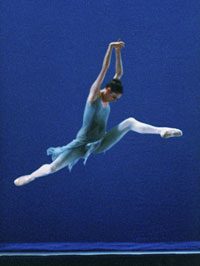
Choreography: Alvin Ailey
Music: Duke Ellington
Alvin Ailey is a name for which Kansas City needs neither introduction nor explanation. Since the 1984 residency here of the Alvin Ailey American Dance Theater, both the company and the director-choreographer-dancer have found Friends aplenty, and this premiere of the 1970 Ellington-Ailey collaboration, The River, is but further evidence of the bonds between the Kansas City Ballet and the Ailey Company. The River, has come to KCB, and soon Bolender’s romping ballet, Summer’s Day, will be added to the Ailey repertoire…an exchange of gifts between friends.
Alvin Ailey is at home among jazz greats, with composers such as Charlie Parker, Mary Lou Williams, Keith Jarrett. He is equally comfortable in the company of Sadie, Thompson and Britten, with the vocabulary of blues and hymns. His choreography makes a seemingly effortless transition from primitive to modern, from jazz to classical. But among these varied inspirations and connections, that of Ailey to Ellington is surely on of the most enduring ns most significant.
The River, commissioned of the duo by American Ballet Theatre was premiered in 1970. In its musical entirety it consists of a “Prologue,” an “Epilogue,” and eleven sections entitled, “Spring,” “Spring Run,” “Meander,” “Giggling Rapids,” “Falls,” “Vortex,” “Lake,” “Mainstream,” “Two Cities,” “The Sea,” and “Spring.” Critic Jean Battey Lewis wrote of the work’s “joyous quality, a life force that carries along its series of solos, duets and group dances in a headlong sweep… not only a well-spring of free, unforced imaginative movement, but also a tribute to Ailey’s gifts…”
It is Walter-Elemental, in natural course, tumbling, turning, reflecting, which Ellington sought to capture in his music, and which Ailey, in turn set in dance. Two of Ellington’s notes as cited by his biographer, Derek Jewell, suggest the composer’s vision: “The Spring, which is like a newborn baby. He’s in his cradle…spouting, spinning, wiggling, gurgling, squirming, squealing, making faces…When he hits the floor for the first time out of the cradle he is about to go into…The Run.” And more, “The Lake: The lake is beautiful and serene. It is all horizontal lines that offer up unrippled reflections. There it is, in all its beauty. God-made and untouched, until people come…people who are God-made and terribly touched by the beauty of the lake. They, in their admiration for it, begin to discover new faces of compatibility in each other, and as a romantic viewpoint develops, they indulge themselves. The whole situation compounds itself into an emotional violence that is even grater than that of the violence of the vortex to come. The lake supports them until, suddenly, they are over the top and down…”
The marriage of creativities which produced The River inspired numerous other works for the Ailey Company. In a 1976 season of “Ailey Celebrates Ellington,” the choreographer presented a broad view of Ellington’s music…works from the composer such as “Harlem,” “The Liberian Suite,” “Night Creature,” “Reflections in D,” and others. Ailey wrote then of Ellington’s pleasure in seeing his music danced: He thought that dance was a major means of communicating what he was trying to get through to people, which was a love of life, and a caring about mankind.”
Dancer-Choreographer William Carter, who with Ailey shares credit for this production, staged The River for the Kansas City Ballet.